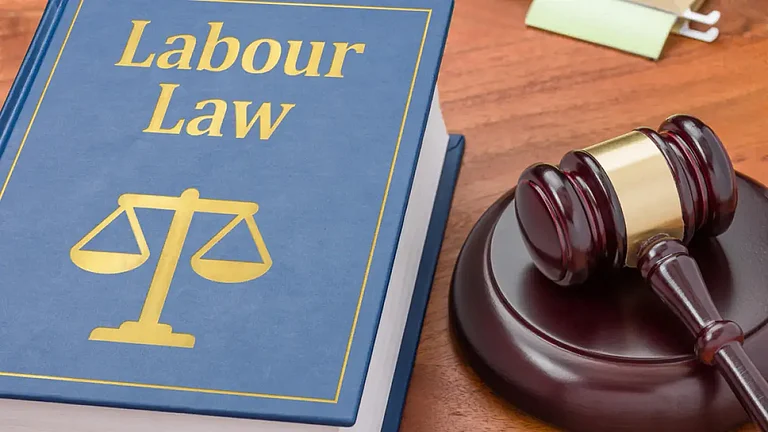Algorithms increasingly manage work, replacing traditional supervisors and challenging existing labour law frameworks.
AI-driven hiring and monitoring risk bias, discrimination, job loss and privacy violations.
Labour laws must adapt, ensuring algorithmic accountability and protecting workers’ rights fairly.
Labour Law in the Age of AI and Automation: Issues and Challenges in Algorithm
Rapid digitalisation and AI-driven automation are transforming workplaces, creating new challenges for labour rights that demand updated laws, algorithmic accountability and a human-centric approach to technology
The massive digitalisation and the future of work have raised critical questions about existing labour law regulations. To understand the legal challenges of AI and automation, we need to look closely at how the workplace itself is changing.
Take gig workers driving for apps like Uber or Ola. These drivers do not have a manager calling the shots in the traditional sense. Instead, an algorithm quietly decides when they work, which routes they take, how much they earn and even whether they will get more rides in the future. Although it is fascinating, it is worrying too because it shows how invisible systems are now acting like bosses.
The same thing happens inside the massive warehouses of e-commerce companies, where workers follow instructions not from supervisors but from computer systems that track their every move down to the minute. In the corporate world, software now screens thousands of CVs almost instantly, using decision-making codes that are impossible for an applicant to question. We have to understand from these examples that algorithms are no longer mere tools but are now becoming the managers of our working lives.
The traditional notion of the employer-employee relationship has been replaced by systematic algorithms that were previously managed by employers. In traditional management, workers raised their concerns and issues before their employer. But today, rapid control by algorithmic management complicates the conventional notion of an employer-employee relationship.
Historical Parallels and Legal Vacuum
Although the historical lessons from the centuries-old Industrial Revolution significantly changed societies, economies and the overall global order, during that period manual labour was substituted with machines in many factories. These developments led to exploitation, which brought major and necessary changes in labour law.
There is a similar legal vacuum today due to the rapid inclusion of technology in workplaces. The speed of technological development is much higher than the speed of regulatory change.
New Challenges for Labour Rights
There is apprehension of job displacement due to the rapid algorithm-based recruiting mechanism. The growing use of automation in work transitions, particularly in sectors such as clerical work, logistics and manufacturing, has created fear among workers who may face redundancy.
According to the International Labour Organisation (ILO), the world is witnessing an unprecedented acceleration in technological advancement and an increasing risk of jobs being automated globally. Still, existing labour laws deal mainly with traditional worker regulations related to job security, while remaining silent on the large-scale job losses caused by algorithmic technology.
The second challenge is related to automated discrimination and bias towards a particular community or gender. AI recruiting tools may quietly perpetuate similar biases, which is more dangerous than the old patterns of discrimination by employers.
Such passive discrimination is more problematic than active discrimination because it is difficult to flag systematic algorithmic bias. Research shows that if hiring software is trained on biased data, it will reproduce that bias in its decisions. It is imperative to understand how AI recruiting tools may turn biased towards gender.
The AI automatic system was trained on data submitted by applicants, and it was found that male applicants were in the majority. Various sources maintained that bias through AI recruiting tools could be perpetuated. The best example is the Amazon case, in which an automated algorithm was effectively trained to give more preference to male applicants. This indicates that the serious problem of discrimination cannot be ruled out by automation tools. It is high time to regulate algorithms to avoid systematic discrimination towards a particular community or gender.
Another important issue relates to the surveillance of workers. In a technological world, automatic monitoring systems do not only record working hours but also track personal information and even make inferences about the mood of workers. For example, a delivery worker may be penalised for choosing a slightly longer route due to safety concerns. It is therefore high time to raise central legal questions on how far technology should be allowed to gather automatic information on workers in a highly digitised global world.
Towards Algorithmic Accountability
The algorithm accountability is the need of the hour to protect workers interests and their rights. The existing law on labour law needs a thorough revision to make automatic technology more robust and “algorithmic transparency”. The workers have right to know how automatic algorithm decisions are being made on their pay, shifts, promotions or even terminations.
Presently, there is no legislative framework to ensure workers rights are protected. Although the positive step has been taken by the EU in its proposed AI Act, which focused on the workers rights. It is a workable step because laws should ensure that technology does not strip people of the ability to question decisions that shape their livelihoods.
Another promising solution is rethinking how we define employment itself. Spain took a bold step when it passed what is known as the “Riders Law”, which officially recognised food delivery riders as employees. This gave them access to rights like collective bargaining and social security. India has also tried something similar through the Code on Social Security, which is supposed to cover gig and platform workers.
But here, the problem has been uneven enforcement, meaning many riders and drivers are still left without meaningful protection. This shows that while legal reform is possible, it takes both strong legislation and genuine commitment to implementation.
Beyond that, the future of labour law must embrace a human-centric vision of technology. This does not mean rejecting automation altogether. Instead, it means ensuring that machines are used to support human welfare, not replace it. If policymakers today focus on building human adaptability, the same kind of shift is possible for workers who might otherwise be left behind by AI.
Interestingly, the highest court of the UK acknowledged that Uber Drivers are workers. The court, in its order, held that Uber Drivers are not contractors but are workers. Furthermore, the court said that “drivers are working when they are signed into the Uber app and ready to work.” It is a huge step and relief for workers because it provides them rights like other employees are enjoying.
Conclusion: Putting People First in the Algorithmic Age
Technology is a reality and the new norm in the workplace. It is the need of the hour, but algorithmic tools should not be allowed to perpetuate violations of workers’ rights. Labour jurisprudence should not remain static in its classical and traditional regulations. Law changes with the changing needs of society and so does labour jurisprudence.
Existing labour law needs to be revised to ensure rights are protected in a technological world, guaranteeing dignity, fairness and protection for workers. The new algorithmic revolution in the workplace requires legislative reforms. We need political courage, creative legal thinking and above all, a clear recognition that algorithms, no matter how complex, must remain accountable to human values.
The views expressed in this article are solely those of the author.


